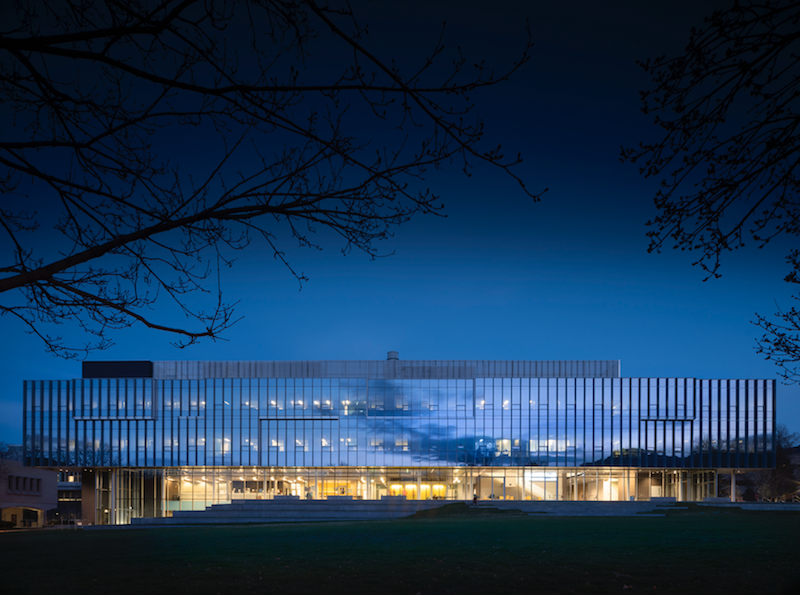The CoorsTek Center, a four-story education and research facility on the Colorado School of Mines campus, has officially been completed.
The Center supports a range of academic and research activities and is the new home for the College of Applied Science and Engineering (CASE) and the Department of Physics. A metal and glass facade is vertically punctuated by service cores clad in dark masonry that help to anchor the building’s entrances. The building’s northwest exterior, which fronts the campus’s Kafadar Commons, comprises full-height glazing at Level 1, and vertical glass panels and metal fins at Levels 2 and 3 that float above and modulate as influenced by the building’s interior program.
In addition to the CASE classrooms, the CoorsTek Center also includes general classroom space such as media-intensive “Active Learning” rooms that are flexible and can be rearranged for group work and discussions. A promenade on Level 1 incorporates seating and collaborative work areas that emulate tech workplaces to prepare students for post-college work life.
See Also: Suffolk breaks ground on large housing/dining complex for UMass Dartmouth
While Level 1 is available for the entire campus, Levels 2 and 3 contain dedicated teaching and research laboratories and faculty and graduate student offices. Below grade are additional lab spaces with specific lighting, sound, or vibration requirements.
Bohlin Cywinski Jackson designed the building in association with Anderson Mason Dale Architects.
Related Stories
| Oct 17, 2011
Clery Act report reveals community colleges lacking integrated mass notification systems
“Detailed Analysis of U.S. College and University Annual Clery Act Reports” study now available.
| Oct 14, 2011
University of New Mexico Science & Math Learning Center attains LEED for Schools Gold
Van H. Gilbert architects enhances sustainability credentials.
| Oct 12, 2011
Bulley & Andrews celebrates 120 years of construction
The family-owned and operated general contractor attributes this significant milestone to the strong foundation built decades ago on honesty, integrity, and service in construction.
| Sep 30, 2011
Design your own floor program
Program allows users to choose from a variety of flooring and line accent colors to create unique floor designs to complement any athletic facility.
| Sep 23, 2011
Okanagan College sets sights on Living Buildings Challenge
The Living Building Challenge requires projects to meet a stringent list of qualifications, including net-zero energy and water consumption, and address critical environmental, social and economic factors.
| Sep 14, 2011
Research shows large gap in safety focus
82% of public, private and 2-year specialized colleges and universities believe they are not very effective at managing safe and secure openings or identities.
| Sep 7, 2011
KSS Architects wins AIA NJ design award
The project was one of three to win the award in the category of Architectural/Non-Residential.
| May 18, 2011
Major Trends in University Residence Halls
They’re not ‘dorms’ anymore. Today’s collegiate housing facilities are lively, state-of-the-art, and green—and a growing sector for Building Teams to explore.
| May 18, 2011
Raphael Viñoly’s serpentine-shaped building snakes up San Francisco hillside
The hillside location for the Ray and Dagmar Dolby Regeneration Medicine building at the University of California, San Francisco, presented a challenge to the Building Team of Raphael Viñoly, SmithGroup, DPR Construction, and Forell/Elsesser Engineers. The 660-foot-long serpentine-shaped building sits on a structural framework 40 to 70 feet off the ground to accommodate the hillside’s steep 60-degree slope.
















